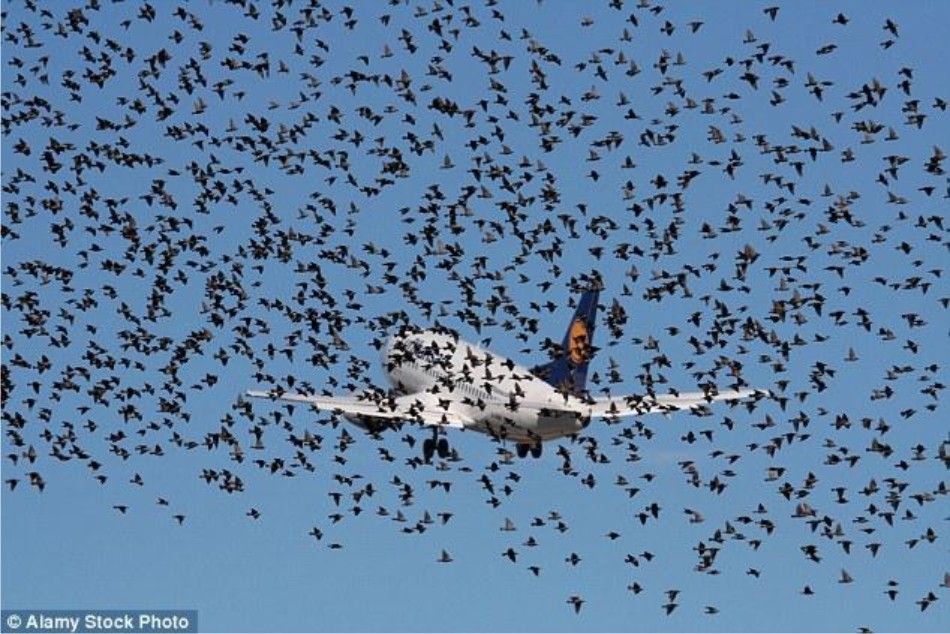
Thousands of airplane bird strikes occur each year, but airports have many safety and conservation measures in place to minimize these potentially damaging and dangerous situations. Thanks to thoughtful airport bird control techniques, the majority of airplane scares involving birds do not result in substantial damage to the aircraft or danger to the passengers. Conscientious airport officials continually monitor nearby wildlife in order to refine bird avoidance procedures, avoid any potential problems, and minimize the impact on birds. Bird-strike events are relatively common, occur most often on the ground or at low altitude, and are usually benign. However, bird strikes can have significant economic and occasional safety consequences for flight operations. Pilots and operators should be knowledgeable about the hazard, and flight crews should use facts, data, and standard operating procedures to reduce the potential for and consequences of a bird strike.
Why Bird Strikes Happen

Despite the best use of multiple deterrent methods and wildlife management, airplane bird strikes still happen. Ornithologists and other researchers examine the snarge, the remains of birds that have impacted with planes, to determine which species are the greatest problem and the most significant risk. With that knowledge, they can continually refine control methods to be more effective without disrupting birds that do not cause problems.
As airports become busier, flights are scheduled more frequently, and alternative habitats continue to shrink, more and more birds will seek refuge near airports, causing potentially dangerous situations. Airports must continuously be on the alert for other fliers in the skies, and as new control and deterrent techniques are developed, it is hoped that bird strikes can continue to be minimized.

Attraction to Airports

Large flocks of birds are hazardous to aircraft, and unfortunately, birds enjoy the habitat around many busy airports. Because airports are placed on the fringe of large urban centers, they frequently have large tracts of unused, undeveloped land surrounding them as noise and safety buffers. That undeveloped land is attractive to birds, particularly as suitable habitat shrinks due to urban expansion. At the same time, the general bustle of the airport often discourages large predators, giving birds a safer sanctuary. Many airports are also near substantial wetlands or drainage ponds since water is a superb noise dampener, making these areas even more attractive to migratory waterfowl, gulls, and other large birds. Unfortunately, the same birds that are most attracted to these habitats can present the most dangerous threats to aircraft.
Bird-strike events are relatively common, occur most often on the ground or at low altitude, and are usually benign. However, bird strikes can have significant economic and occasional safety consequences for flight operations. Pilots and operators should be knowledgeable about the hazard, and flight crews should use facts, data, and standard operating procedures to reduce the potential for and consequences of a bird strike.
Preventive Strategies
Airports are responsible for bird control and should provide adequate wildlife control measures. If large birds or flocks of birds are reported or observed near the runway, the flight crew should consider:
Delaying the takeoff or landing when fuel permits. Advise the tower and wait for airport action before continuing.
Take off or land on another runway that is free of bird activity, if available.
To prevent or reduce the consequences of a bird strike, the flight crew should:
Discuss bird strikes during takeoff and approach briefings when operating at airports with known or suspected bird activity.
Be extremely vigilant if birds are reported on final approach. If birds are expected on final approach, plan additional landing distance to account for the possibility of no thrust reverser use if a bird strike occurs.
Minimizing Bird Strikes
Both large birds and flocks of smaller birds can be dangerous to planes, either by impacting the windscreen or being sucked into the engines. This not only causes significant damage to the plane but can also create hazardous and unsafe flying conditions if critical damage occurs. Because of this, many airports have wildlife control initiatives in place to minimize any interaction between birds and aircraft.
There are three general ways to minimize airplane bird strikes: modifying the birds’ habitat, controlling the birds’ behavior, and modifying aircrafts’ behavior. Airports that are most successful at minimizing bird strikes have employed all three methods through various techniques.
Habitat
Modifying the habitat surrounding an airport so it will not appeal to birds is an easy way to encourage wild birds to seek alternative roosting and feeding grounds. Effective measures include:
Removing seed-bearing plants to eliminate food sources
Using insecticides or pesticides to eliminate food sources for insect-eating birds
Covering nearby ponds with netting to prevent birds from landing
Removing brush and trees that serve as attractive nesting sites
Keeping grass mowed short so it is not as suitable for bird shelter
Bird Behavior
Several methods can be used to modify birds’ behavior, so they will not stay near an airport. These techniques do not harm the birds but encourage them to avoid the region.
Using sonic cannons, recorded predator calls, and other noise generators to disrupt birds.
Using lasers at dawn and dusk to simulate predators and scare birds away.
Flying trained falcons over roosting areas to disrupt birds before they nest.
Training dogs to track through the habitat and teach birds that the area has many predators.
As a last resort, birds may be captured and relocated by authorized wildlife control officials if they cannot be encouraged to leave the area naturally. In extreme cases, birds may be culled with the proper authorization.
Plane Schedules
Learning to work with the birds by modifying flight paths and schedules can help minimize bird strikes. While these methods may not be feasible at all airports, they can be used to help the airport work in harmony with the wildlife surrounding it.
Training spotters with binoculars and scopes to pinpoint hazardous birds and directing planes to different runways or approaches.
Using radar equipment to track the movement and density of bird flocks to predict their behavior and manage control techniques more effectively.
Adjusting flight times to avoid the busiest hours for bird activity, such as early morning and late evening or during peak migration periods.
How airlines can get involved
Airlines and other stakeholders can help address the ongoing problem of bird strikes by participating in local, regional, national, or international aviation wildlife hazard activities, such as bird-strike committees or equivalent groups.
Airlines can also form their own internal aviation wildlife hazard group and designate a single point of contact for coordinating all aviation wildlife hazard activity, both internally and externally.
Culled from The Spruce website
 MMS PLUS NG – Maritime, Aviation, Business, Oil and Gas News Online Newspaper with coverage in Maritime, Oil and Gas, Aviation, Power and Energy as well as Financial News
MMS PLUS NG – Maritime, Aviation, Business, Oil and Gas News Online Newspaper with coverage in Maritime, Oil and Gas, Aviation, Power and Energy as well as Financial News









